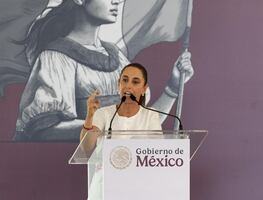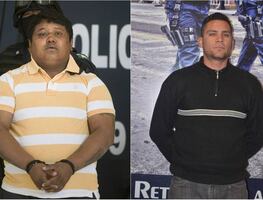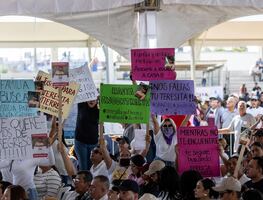Más Información

Osiel Cárdenas, exlíder del Cártel del Golfo, recibe auto de formal prisión; enfrentará juicio por homicidio

Jóvenes mexicanos pasan más de 2 mil horas al año en el teléfono; OCDE alerta sobre su impacto en la salud mental

Sergio Gutiérrez Luna destaca aprobación de 25 reformas en la 66 Legislatura; "Un logro histórico para la 4T", señala

Secretario de Agricultura reafirma defensa del maíz blanco; "Seguiremos apoyando la producción nacional no transgénica", afirma

¿Maíz transgénero? Rubén Rocha corrige desliz durante discurso en Sinaloa; destaca importancia del maíz blanco

Sheinbaum asegura apoyo total a Sinaloa para enfrentar violencia; "Nunca los vamos a dejar solos, aquí está la presidenta"
Across the world, as the Jamal Khashoggi case dramatically shows, journalism and freedom of speech are threatened by authoritarian regimes, organized crime, corporations, and individuals interested in hiding their human rights violations, illegal profits, and abuses.
According to the New York-based Committee to Protect Journalists ( CPJ ), one of the most respected institutions working on this issue, new information technologies—the global, interconnected internet , ubiquitous social media platforms, smartphones with cameras—were supposed to make censorship obsolete.
Instead, they have just made it more complicated.
Following the polarizing election of Donald Trump in the United States , concerns were raised about the rise of fake news and the hostile and intimidating environment created by Trump’s heated rhetoric.
Yet around the world, says the CPJ, the trends are deeper, more enduring and more troubling.
The strategies to control and manage information fall into an update on the worst old-style tactics, from state censorship to the imprisonment of critics, while masked political control means a systematic effort to hide repressive actions by dressing them in the cloak of democratic norms.
In the same vein, “ technology capture ” means using the same technologies that have spawned the global information explosion to stifle dissent, by monitoring and surveilling critics, blocking websites and using trolling to shout down critical voices.
“Most insidious of all is sowing confusion through propaganda and false news”, the CPJ added.
In Mexico , at least 11 journalists have been killed this year, said the National Commission on Human Rights ( CNDH ) and the office of the United Nations High Commissioner for Human Rights in the country.
The victims included José Gerardo Martínez , 35, editor of the news agency Servicio Universal de Noticias ( SUN ) from EL UNIVERSAL . Martínez was robbed and shot on January 6 in Mexico City , and the alleged perpetrators have not been arrested.
At least 62 journalists have been killed during the six-year term of the outgoing federal administration; for its part, the office in Mexico and Central America of the nonprofit organization Artículo 19 remarked that Mexico continues to be the most dangerous Latin American country for journalistic work , and the violence levels are comparable to those registered in nations at war such as Syria.
Insufficient protection
Artículo 19
said that 119 Mexican journalists have been killed since 2000; another 1,986 threats and attacks were reported in the last six years.
For its part, a report released this week in Mexico City by the Center for Justice and International Law ( CEJIL ) and Protection International ( PI ) stressed that the current Latin American mechanisms to protect journalists and human rights activists lacks international standards and are only focused in security and risks, without a more comprehensive approach on the right to defend human rights through the active participation of the people involved in this activity and journalists.
Apart from the Khashoggi case , this year other 44 journalists have been killed , 27 of them deliberately murdered , in several countries.
Among the recent cases, Daphne Caruana Galizia , who worked on the Panama Papers with the International Consortium of Investigative Journalists , died a year ago this month when she was probing the links between politicians and criminals in her native Malta .
A few months later in Slovakia , a gunman shot dead investigative reporter Ján Kuciak along with his fiancée. Kuciak, 27 was working on the European country’s top political and business leaders , including alleged links to the Italian mafia .
Last Friday, a 21-year old suspect in the rape and slaying of a Bulgarian television journalist said that he killed Viktoria Marinova , yet did not mean to.
Handcuffed and surrounded by police officers, Severin Krassimirov spoke to reporters inside a courtroom in the northern city of Ruse where he appeared for a custody hearing.
Prior to that, Krassimirov said he was under the influence of alcohol and drugs when he got into an argument with a woman he did not know on October 6.
However, Marinova, 30, was a presenter on a current affairs talk programme called Detector for TVN .
Its first episode featured an interview with two Bulgarian investigative journalists exploring alleged fraud involving European Union funds linked to businessmen and politicians .
The pair, Attila Biro and Dimitar Stoyanov , were arrested in September while looking into the case.
Marinova
is the third high-profile journalist to be killed in the European Union in the past year, and the fourth since the start of 2017.
Editing by Sofía Danis
More by Gabriel Moyssen





